The Structure of the Business
VerifiedAdded on 2022/11/24
|13
|4302
|300
AI Summary
This document discusses the different legal structures that a new business may opt for, along with the strengths and weaknesses of each. It also explores three sources of finance available to business startups and provides an overview of the three sectors within the UK economy. The document concludes with an analysis of the value of these sectors to the UK economy.
Contribute Materials
Your contribution can guide someone’s learning journey. Share your
documents today.
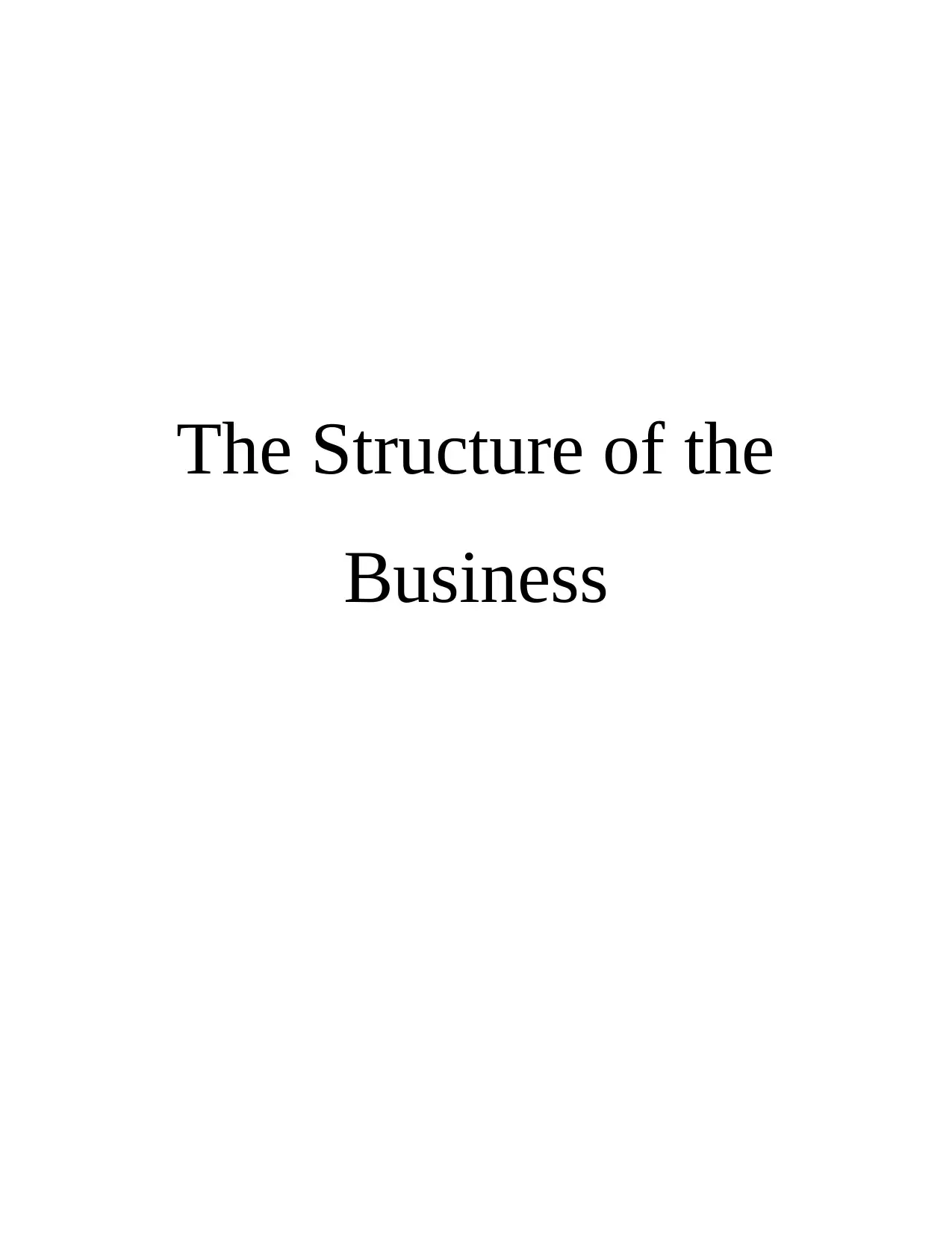
The Structure of the
Business
Business
Secure Best Marks with AI Grader
Need help grading? Try our AI Grader for instant feedback on your assignments.
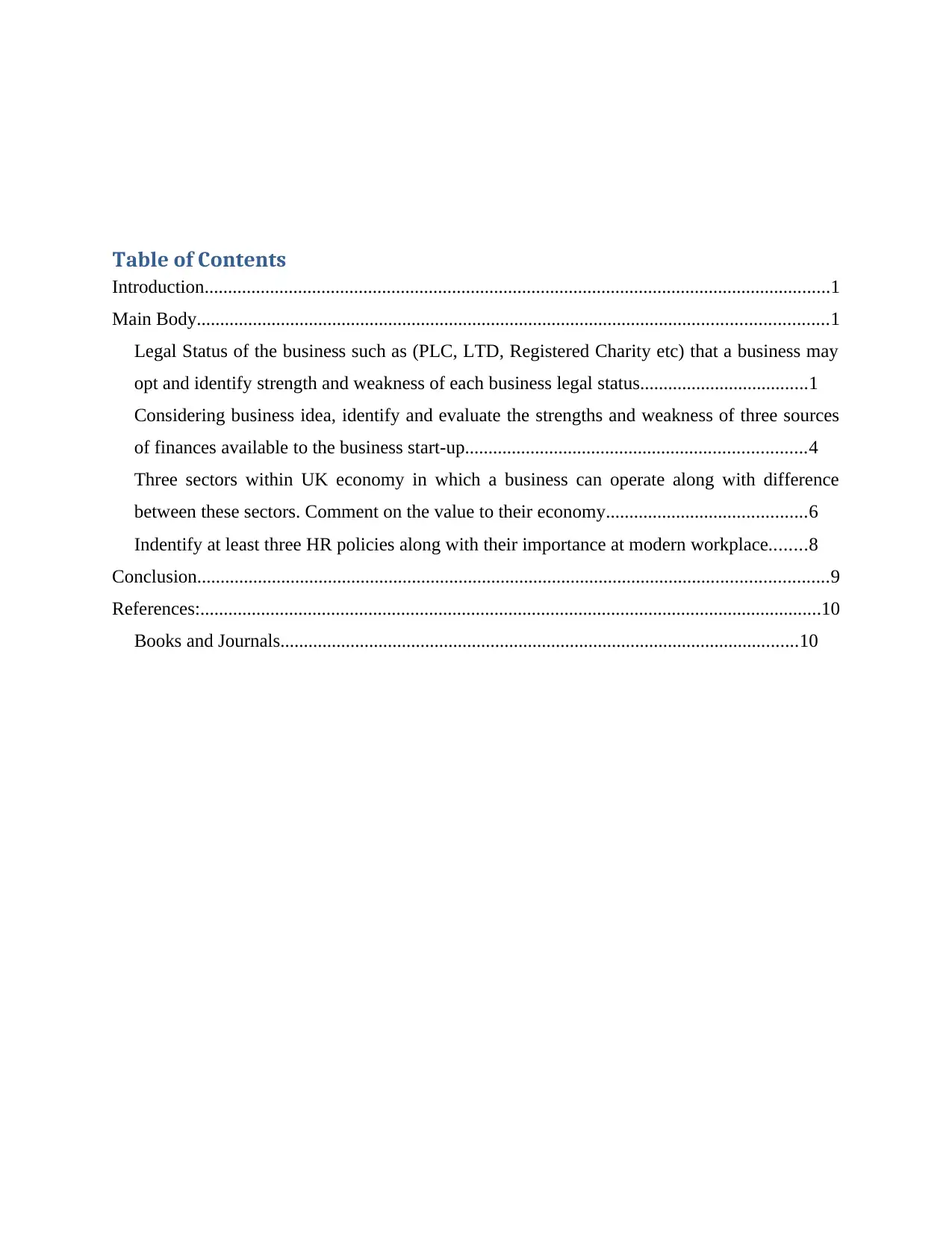
Table of Contents
Introduction......................................................................................................................................1
Main Body.......................................................................................................................................1
Legal Status of the business such as (PLC, LTD, Registered Charity etc) that a business may
opt and identify strength and weakness of each business legal status....................................1
Considering business idea, identify and evaluate the strengths and weakness of three sources
of finances available to the business start-up.........................................................................4
Three sectors within UK economy in which a business can operate along with difference
between these sectors. Comment on the value to their economy...........................................6
Indentify at least three HR policies along with their importance at modern workplace........8
Conclusion.......................................................................................................................................9
References:.....................................................................................................................................10
Books and Journals...............................................................................................................10
Introduction......................................................................................................................................1
Main Body.......................................................................................................................................1
Legal Status of the business such as (PLC, LTD, Registered Charity etc) that a business may
opt and identify strength and weakness of each business legal status....................................1
Considering business idea, identify and evaluate the strengths and weakness of three sources
of finances available to the business start-up.........................................................................4
Three sectors within UK economy in which a business can operate along with difference
between these sectors. Comment on the value to their economy...........................................6
Indentify at least three HR policies along with their importance at modern workplace........8
Conclusion.......................................................................................................................................9
References:.....................................................................................................................................10
Books and Journals...............................................................................................................10
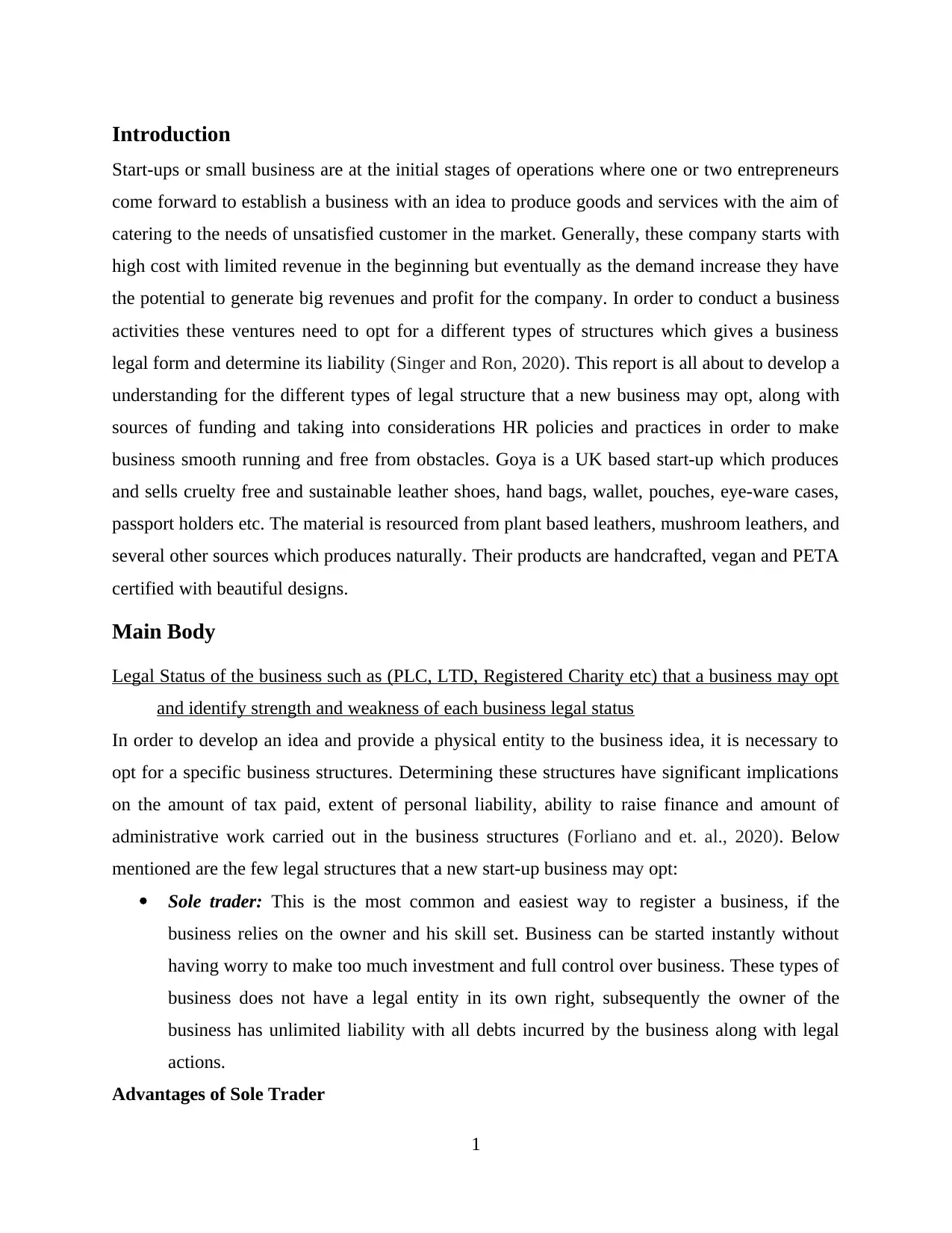
Introduction
Start-ups or small business are at the initial stages of operations where one or two entrepreneurs
come forward to establish a business with an idea to produce goods and services with the aim of
catering to the needs of unsatisfied customer in the market. Generally, these company starts with
high cost with limited revenue in the beginning but eventually as the demand increase they have
the potential to generate big revenues and profit for the company. In order to conduct a business
activities these ventures need to opt for a different types of structures which gives a business
legal form and determine its liability (Singer and Ron, 2020). This report is all about to develop a
understanding for the different types of legal structure that a new business may opt, along with
sources of funding and taking into considerations HR policies and practices in order to make
business smooth running and free from obstacles. Goya is a UK based start-up which produces
and sells cruelty free and sustainable leather shoes, hand bags, wallet, pouches, eye-ware cases,
passport holders etc. The material is resourced from plant based leathers, mushroom leathers, and
several other sources which produces naturally. Their products are handcrafted, vegan and PETA
certified with beautiful designs.
Main Body
Legal Status of the business such as (PLC, LTD, Registered Charity etc) that a business may opt
and identify strength and weakness of each business legal status
In order to develop an idea and provide a physical entity to the business idea, it is necessary to
opt for a specific business structures. Determining these structures have significant implications
on the amount of tax paid, extent of personal liability, ability to raise finance and amount of
administrative work carried out in the business structures (Forliano and et. al., 2020). Below
mentioned are the few legal structures that a new start-up business may opt:
Sole trader: This is the most common and easiest way to register a business, if the
business relies on the owner and his skill set. Business can be started instantly without
having worry to make too much investment and full control over business. These types of
business does not have a legal entity in its own right, subsequently the owner of the
business has unlimited liability with all debts incurred by the business along with legal
actions.
Advantages of Sole Trader
1
Start-ups or small business are at the initial stages of operations where one or two entrepreneurs
come forward to establish a business with an idea to produce goods and services with the aim of
catering to the needs of unsatisfied customer in the market. Generally, these company starts with
high cost with limited revenue in the beginning but eventually as the demand increase they have
the potential to generate big revenues and profit for the company. In order to conduct a business
activities these ventures need to opt for a different types of structures which gives a business
legal form and determine its liability (Singer and Ron, 2020). This report is all about to develop a
understanding for the different types of legal structure that a new business may opt, along with
sources of funding and taking into considerations HR policies and practices in order to make
business smooth running and free from obstacles. Goya is a UK based start-up which produces
and sells cruelty free and sustainable leather shoes, hand bags, wallet, pouches, eye-ware cases,
passport holders etc. The material is resourced from plant based leathers, mushroom leathers, and
several other sources which produces naturally. Their products are handcrafted, vegan and PETA
certified with beautiful designs.
Main Body
Legal Status of the business such as (PLC, LTD, Registered Charity etc) that a business may opt
and identify strength and weakness of each business legal status
In order to develop an idea and provide a physical entity to the business idea, it is necessary to
opt for a specific business structures. Determining these structures have significant implications
on the amount of tax paid, extent of personal liability, ability to raise finance and amount of
administrative work carried out in the business structures (Forliano and et. al., 2020). Below
mentioned are the few legal structures that a new start-up business may opt:
Sole trader: This is the most common and easiest way to register a business, if the
business relies on the owner and his skill set. Business can be started instantly without
having worry to make too much investment and full control over business. These types of
business does not have a legal entity in its own right, subsequently the owner of the
business has unlimited liability with all debts incurred by the business along with legal
actions.
Advantages of Sole Trader
1
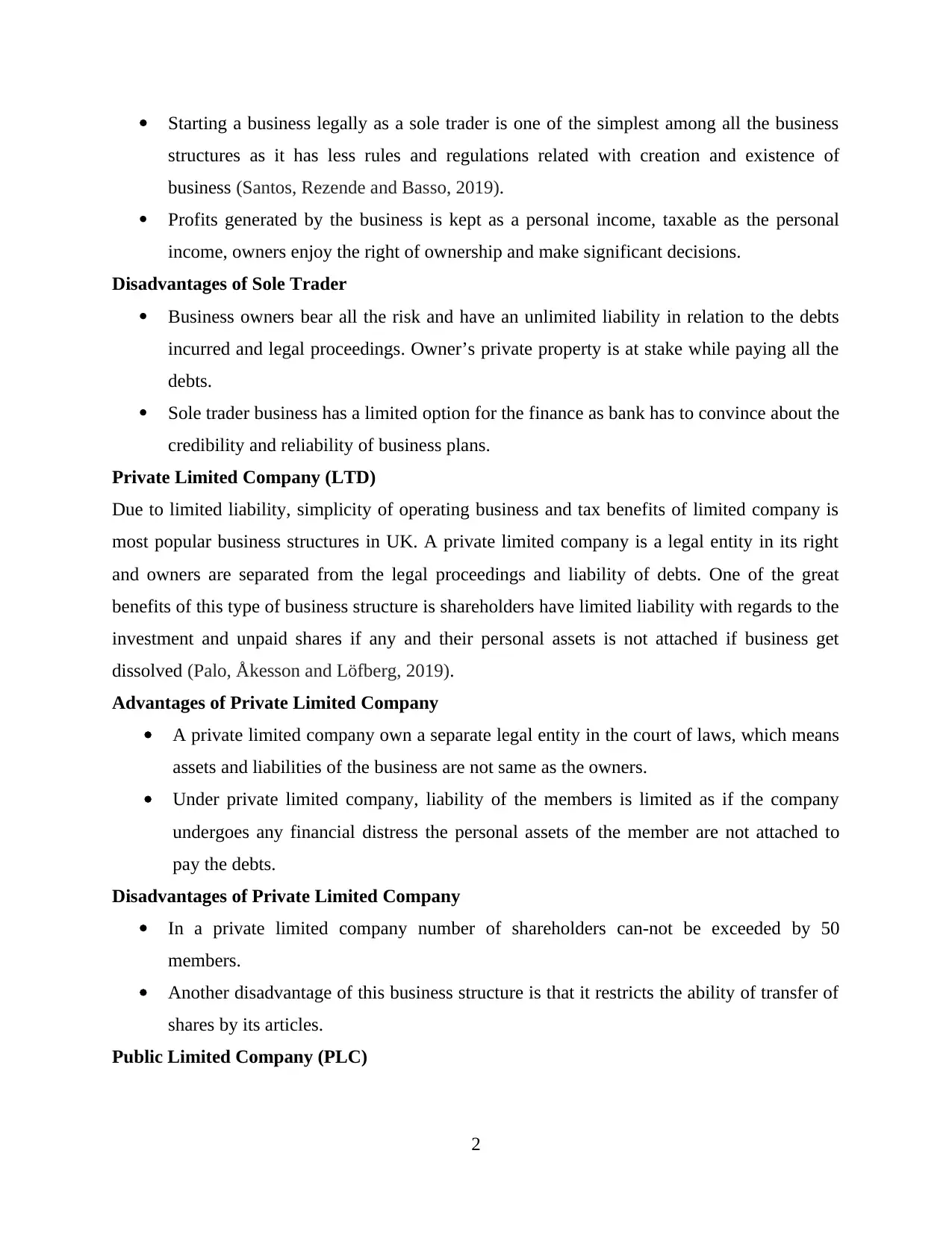
Starting a business legally as a sole trader is one of the simplest among all the business
structures as it has less rules and regulations related with creation and existence of
business (Santos, Rezende and Basso, 2019).
Profits generated by the business is kept as a personal income, taxable as the personal
income, owners enjoy the right of ownership and make significant decisions.
Disadvantages of Sole Trader
Business owners bear all the risk and have an unlimited liability in relation to the debts
incurred and legal proceedings. Owner’s private property is at stake while paying all the
debts.
Sole trader business has a limited option for the finance as bank has to convince about the
credibility and reliability of business plans.
Private Limited Company (LTD)
Due to limited liability, simplicity of operating business and tax benefits of limited company is
most popular business structures in UK. A private limited company is a legal entity in its right
and owners are separated from the legal proceedings and liability of debts. One of the great
benefits of this type of business structure is shareholders have limited liability with regards to the
investment and unpaid shares if any and their personal assets is not attached if business get
dissolved (Palo, Åkesson and Löfberg, 2019).
Advantages of Private Limited Company
A private limited company own a separate legal entity in the court of laws, which means
assets and liabilities of the business are not same as the owners.
Under private limited company, liability of the members is limited as if the company
undergoes any financial distress the personal assets of the member are not attached to
pay the debts.
Disadvantages of Private Limited Company
In a private limited company number of shareholders can-not be exceeded by 50
members.
Another disadvantage of this business structure is that it restricts the ability of transfer of
shares by its articles.
Public Limited Company (PLC)
2
structures as it has less rules and regulations related with creation and existence of
business (Santos, Rezende and Basso, 2019).
Profits generated by the business is kept as a personal income, taxable as the personal
income, owners enjoy the right of ownership and make significant decisions.
Disadvantages of Sole Trader
Business owners bear all the risk and have an unlimited liability in relation to the debts
incurred and legal proceedings. Owner’s private property is at stake while paying all the
debts.
Sole trader business has a limited option for the finance as bank has to convince about the
credibility and reliability of business plans.
Private Limited Company (LTD)
Due to limited liability, simplicity of operating business and tax benefits of limited company is
most popular business structures in UK. A private limited company is a legal entity in its right
and owners are separated from the legal proceedings and liability of debts. One of the great
benefits of this type of business structure is shareholders have limited liability with regards to the
investment and unpaid shares if any and their personal assets is not attached if business get
dissolved (Palo, Åkesson and Löfberg, 2019).
Advantages of Private Limited Company
A private limited company own a separate legal entity in the court of laws, which means
assets and liabilities of the business are not same as the owners.
Under private limited company, liability of the members is limited as if the company
undergoes any financial distress the personal assets of the member are not attached to
pay the debts.
Disadvantages of Private Limited Company
In a private limited company number of shareholders can-not be exceeded by 50
members.
Another disadvantage of this business structure is that it restricts the ability of transfer of
shares by its articles.
Public Limited Company (PLC)
2
Secure Best Marks with AI Grader
Need help grading? Try our AI Grader for instant feedback on your assignments.
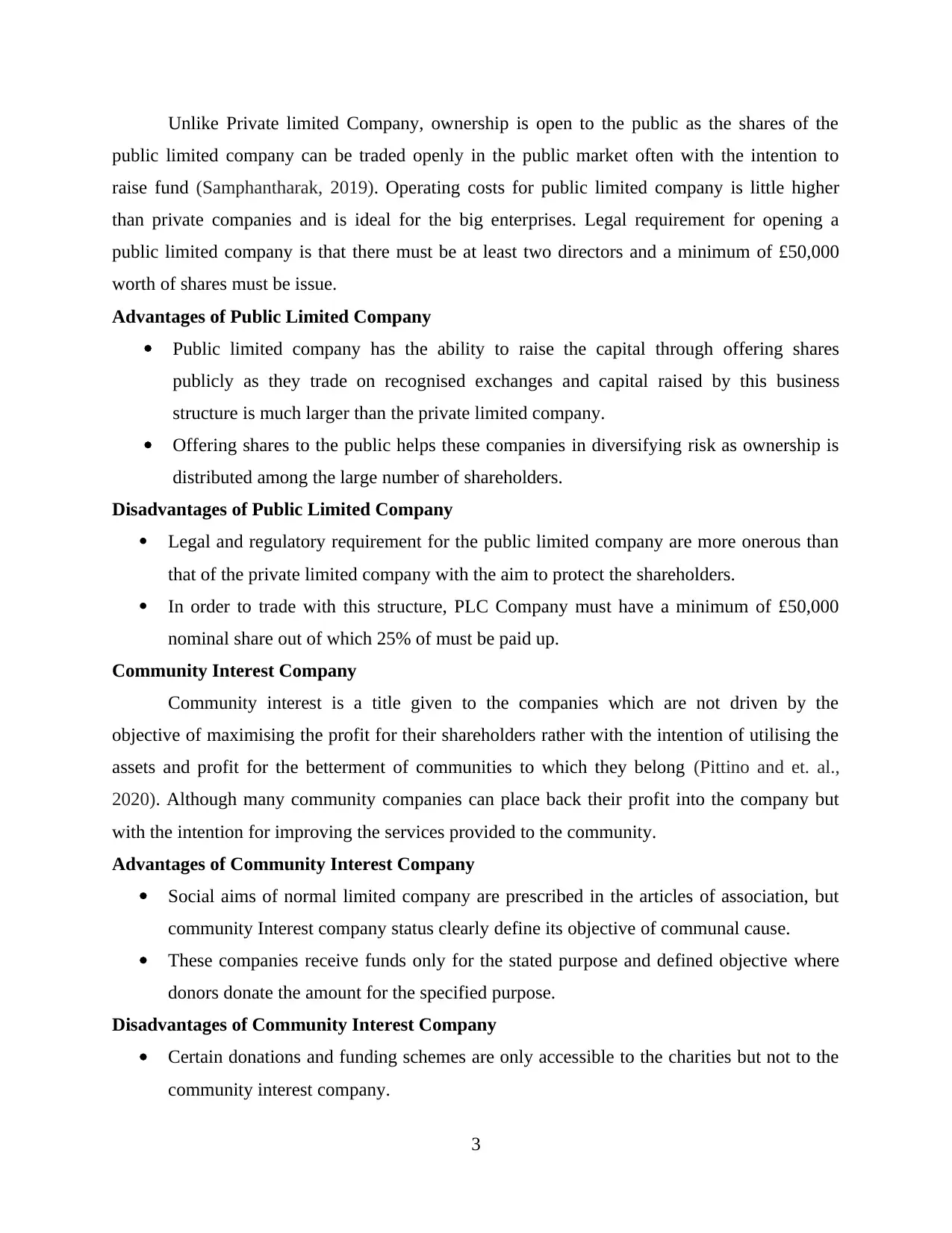
Unlike Private limited Company, ownership is open to the public as the shares of the
public limited company can be traded openly in the public market often with the intention to
raise fund (Samphantharak, 2019). Operating costs for public limited company is little higher
than private companies and is ideal for the big enterprises. Legal requirement for opening a
public limited company is that there must be at least two directors and a minimum of £50,000
worth of shares must be issue.
Advantages of Public Limited Company
Public limited company has the ability to raise the capital through offering shares
publicly as they trade on recognised exchanges and capital raised by this business
structure is much larger than the private limited company.
Offering shares to the public helps these companies in diversifying risk as ownership is
distributed among the large number of shareholders.
Disadvantages of Public Limited Company
Legal and regulatory requirement for the public limited company are more onerous than
that of the private limited company with the aim to protect the shareholders.
In order to trade with this structure, PLC Company must have a minimum of £50,000
nominal share out of which 25% of must be paid up.
Community Interest Company
Community interest is a title given to the companies which are not driven by the
objective of maximising the profit for their shareholders rather with the intention of utilising the
assets and profit for the betterment of communities to which they belong (Pittino and et. al.,
2020). Although many community companies can place back their profit into the company but
with the intention for improving the services provided to the community.
Advantages of Community Interest Company
Social aims of normal limited company are prescribed in the articles of association, but
community Interest company status clearly define its objective of communal cause.
These companies receive funds only for the stated purpose and defined objective where
donors donate the amount for the specified purpose.
Disadvantages of Community Interest Company
Certain donations and funding schemes are only accessible to the charities but not to the
community interest company.
3
public limited company can be traded openly in the public market often with the intention to
raise fund (Samphantharak, 2019). Operating costs for public limited company is little higher
than private companies and is ideal for the big enterprises. Legal requirement for opening a
public limited company is that there must be at least two directors and a minimum of £50,000
worth of shares must be issue.
Advantages of Public Limited Company
Public limited company has the ability to raise the capital through offering shares
publicly as they trade on recognised exchanges and capital raised by this business
structure is much larger than the private limited company.
Offering shares to the public helps these companies in diversifying risk as ownership is
distributed among the large number of shareholders.
Disadvantages of Public Limited Company
Legal and regulatory requirement for the public limited company are more onerous than
that of the private limited company with the aim to protect the shareholders.
In order to trade with this structure, PLC Company must have a minimum of £50,000
nominal share out of which 25% of must be paid up.
Community Interest Company
Community interest is a title given to the companies which are not driven by the
objective of maximising the profit for their shareholders rather with the intention of utilising the
assets and profit for the betterment of communities to which they belong (Pittino and et. al.,
2020). Although many community companies can place back their profit into the company but
with the intention for improving the services provided to the community.
Advantages of Community Interest Company
Social aims of normal limited company are prescribed in the articles of association, but
community Interest company status clearly define its objective of communal cause.
These companies receive funds only for the stated purpose and defined objective where
donors donate the amount for the specified purpose.
Disadvantages of Community Interest Company
Certain donations and funding schemes are only accessible to the charities but not to the
community interest company.
3
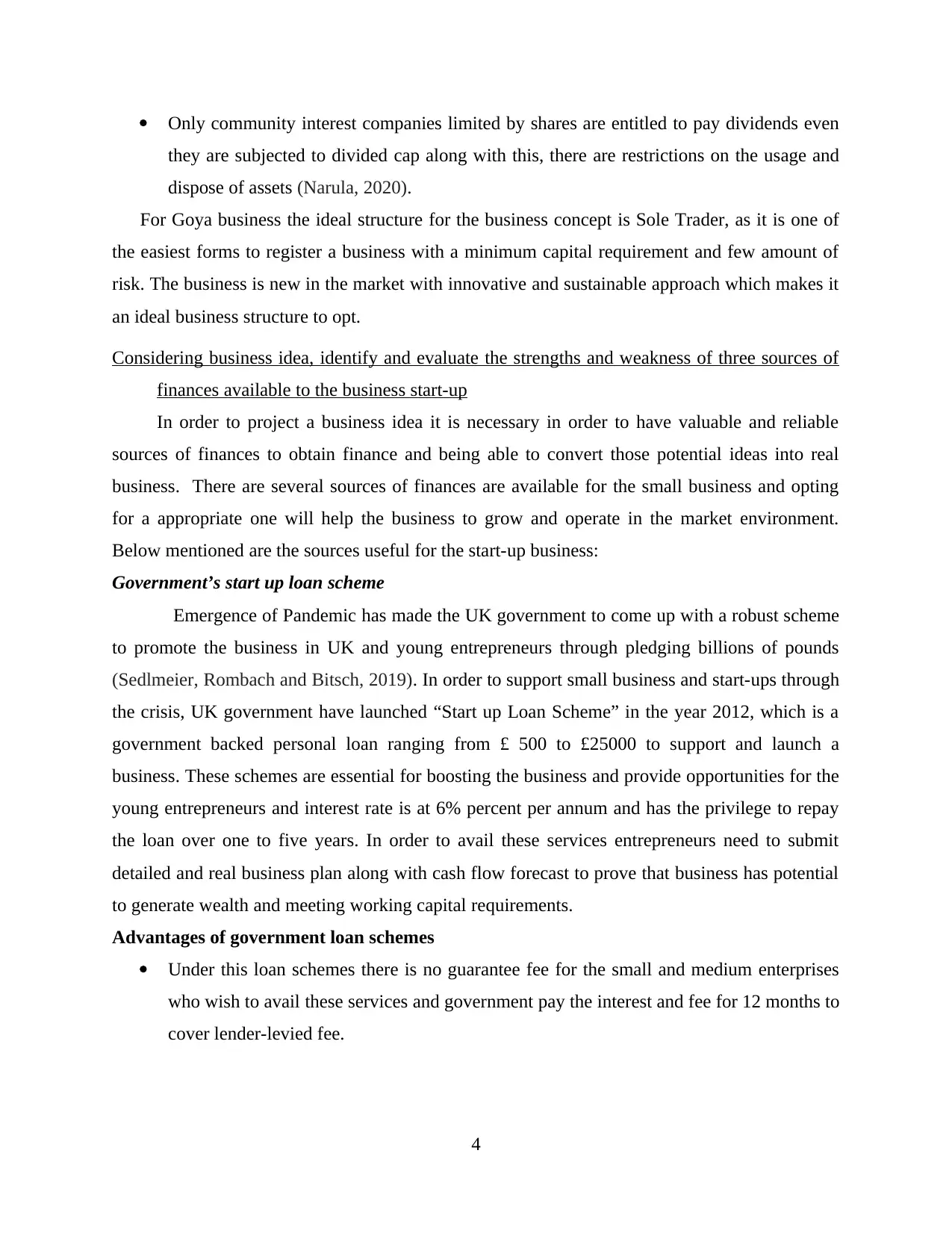
Only community interest companies limited by shares are entitled to pay dividends even
they are subjected to divided cap along with this, there are restrictions on the usage and
dispose of assets (Narula, 2020).
For Goya business the ideal structure for the business concept is Sole Trader, as it is one of
the easiest forms to register a business with a minimum capital requirement and few amount of
risk. The business is new in the market with innovative and sustainable approach which makes it
an ideal business structure to opt.
Considering business idea, identify and evaluate the strengths and weakness of three sources of
finances available to the business start-up
In order to project a business idea it is necessary in order to have valuable and reliable
sources of finances to obtain finance and being able to convert those potential ideas into real
business. There are several sources of finances are available for the small business and opting
for a appropriate one will help the business to grow and operate in the market environment.
Below mentioned are the sources useful for the start-up business:
Government’s start up loan scheme
Emergence of Pandemic has made the UK government to come up with a robust scheme
to promote the business in UK and young entrepreneurs through pledging billions of pounds
(Sedlmeier, Rombach and Bitsch, 2019). In order to support small business and start-ups through
the crisis, UK government have launched “Start up Loan Scheme” in the year 2012, which is a
government backed personal loan ranging from £ 500 to £25000 to support and launch a
business. These schemes are essential for boosting the business and provide opportunities for the
young entrepreneurs and interest rate is at 6% percent per annum and has the privilege to repay
the loan over one to five years. In order to avail these services entrepreneurs need to submit
detailed and real business plan along with cash flow forecast to prove that business has potential
to generate wealth and meeting working capital requirements.
Advantages of government loan schemes
Under this loan schemes there is no guarantee fee for the small and medium enterprises
who wish to avail these services and government pay the interest and fee for 12 months to
cover lender-levied fee.
4
they are subjected to divided cap along with this, there are restrictions on the usage and
dispose of assets (Narula, 2020).
For Goya business the ideal structure for the business concept is Sole Trader, as it is one of
the easiest forms to register a business with a minimum capital requirement and few amount of
risk. The business is new in the market with innovative and sustainable approach which makes it
an ideal business structure to opt.
Considering business idea, identify and evaluate the strengths and weakness of three sources of
finances available to the business start-up
In order to project a business idea it is necessary in order to have valuable and reliable
sources of finances to obtain finance and being able to convert those potential ideas into real
business. There are several sources of finances are available for the small business and opting
for a appropriate one will help the business to grow and operate in the market environment.
Below mentioned are the sources useful for the start-up business:
Government’s start up loan scheme
Emergence of Pandemic has made the UK government to come up with a robust scheme
to promote the business in UK and young entrepreneurs through pledging billions of pounds
(Sedlmeier, Rombach and Bitsch, 2019). In order to support small business and start-ups through
the crisis, UK government have launched “Start up Loan Scheme” in the year 2012, which is a
government backed personal loan ranging from £ 500 to £25000 to support and launch a
business. These schemes are essential for boosting the business and provide opportunities for the
young entrepreneurs and interest rate is at 6% percent per annum and has the privilege to repay
the loan over one to five years. In order to avail these services entrepreneurs need to submit
detailed and real business plan along with cash flow forecast to prove that business has potential
to generate wealth and meeting working capital requirements.
Advantages of government loan schemes
Under this loan schemes there is no guarantee fee for the small and medium enterprises
who wish to avail these services and government pay the interest and fee for 12 months to
cover lender-levied fee.
4
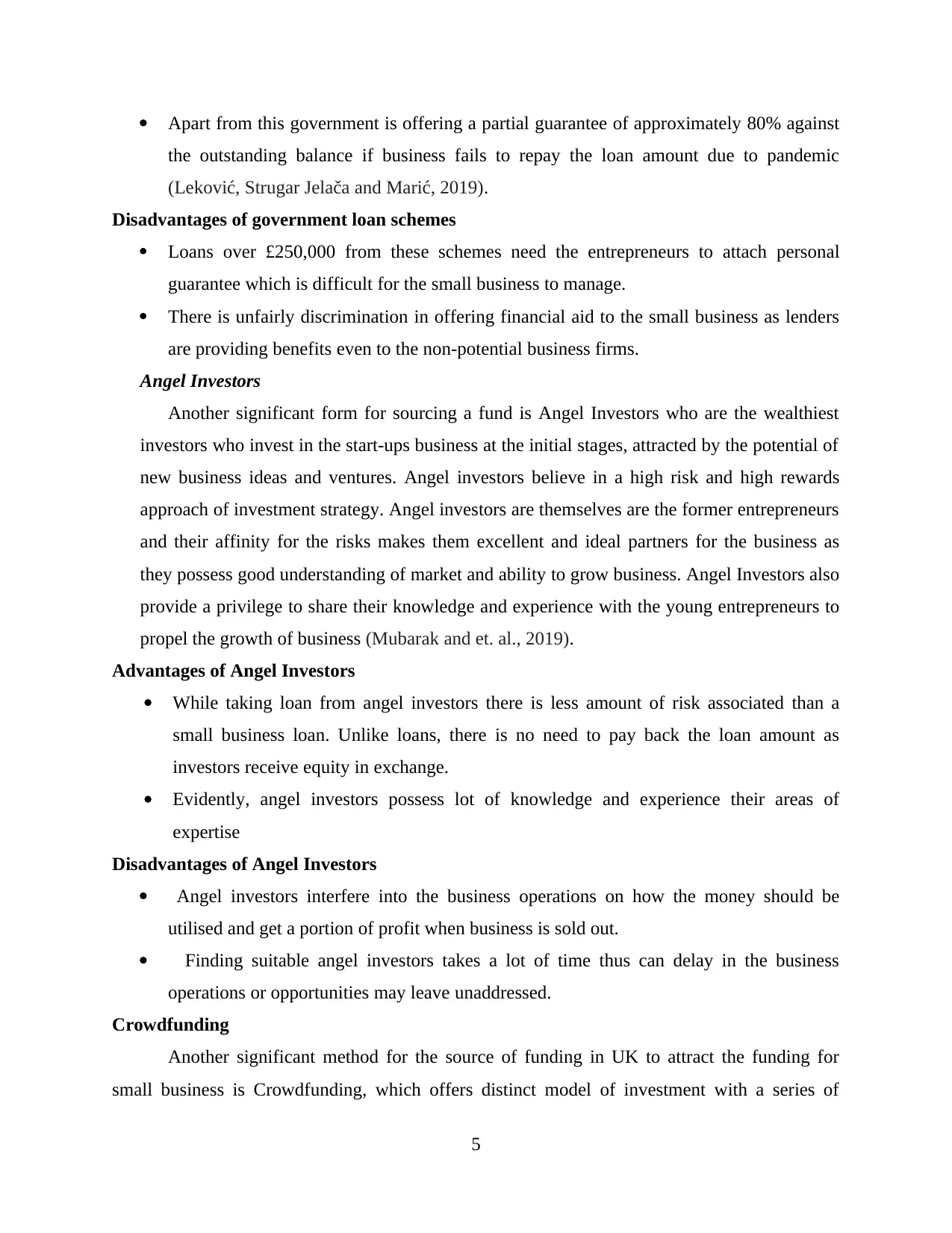
Apart from this government is offering a partial guarantee of approximately 80% against
the outstanding balance if business fails to repay the loan amount due to pandemic
(Leković, Strugar Jelača and Marić, 2019).
Disadvantages of government loan schemes
Loans over £250,000 from these schemes need the entrepreneurs to attach personal
guarantee which is difficult for the small business to manage.
There is unfairly discrimination in offering financial aid to the small business as lenders
are providing benefits even to the non-potential business firms.
Angel Investors
Another significant form for sourcing a fund is Angel Investors who are the wealthiest
investors who invest in the start-ups business at the initial stages, attracted by the potential of
new business ideas and ventures. Angel investors believe in a high risk and high rewards
approach of investment strategy. Angel investors are themselves are the former entrepreneurs
and their affinity for the risks makes them excellent and ideal partners for the business as
they possess good understanding of market and ability to grow business. Angel Investors also
provide a privilege to share their knowledge and experience with the young entrepreneurs to
propel the growth of business (Mubarak and et. al., 2019).
Advantages of Angel Investors
While taking loan from angel investors there is less amount of risk associated than a
small business loan. Unlike loans, there is no need to pay back the loan amount as
investors receive equity in exchange.
Evidently, angel investors possess lot of knowledge and experience their areas of
expertise
Disadvantages of Angel Investors
Angel investors interfere into the business operations on how the money should be
utilised and get a portion of profit when business is sold out.
Finding suitable angel investors takes a lot of time thus can delay in the business
operations or opportunities may leave unaddressed.
Crowdfunding
Another significant method for the source of funding in UK to attract the funding for
small business is Crowdfunding, which offers distinct model of investment with a series of
5
the outstanding balance if business fails to repay the loan amount due to pandemic
(Leković, Strugar Jelača and Marić, 2019).
Disadvantages of government loan schemes
Loans over £250,000 from these schemes need the entrepreneurs to attach personal
guarantee which is difficult for the small business to manage.
There is unfairly discrimination in offering financial aid to the small business as lenders
are providing benefits even to the non-potential business firms.
Angel Investors
Another significant form for sourcing a fund is Angel Investors who are the wealthiest
investors who invest in the start-ups business at the initial stages, attracted by the potential of
new business ideas and ventures. Angel investors believe in a high risk and high rewards
approach of investment strategy. Angel investors are themselves are the former entrepreneurs
and their affinity for the risks makes them excellent and ideal partners for the business as
they possess good understanding of market and ability to grow business. Angel Investors also
provide a privilege to share their knowledge and experience with the young entrepreneurs to
propel the growth of business (Mubarak and et. al., 2019).
Advantages of Angel Investors
While taking loan from angel investors there is less amount of risk associated than a
small business loan. Unlike loans, there is no need to pay back the loan amount as
investors receive equity in exchange.
Evidently, angel investors possess lot of knowledge and experience their areas of
expertise
Disadvantages of Angel Investors
Angel investors interfere into the business operations on how the money should be
utilised and get a portion of profit when business is sold out.
Finding suitable angel investors takes a lot of time thus can delay in the business
operations or opportunities may leave unaddressed.
Crowdfunding
Another significant method for the source of funding in UK to attract the funding for
small business is Crowdfunding, which offers distinct model of investment with a series of
5
Paraphrase This Document
Need a fresh take? Get an instant paraphrase of this document with our AI Paraphraser
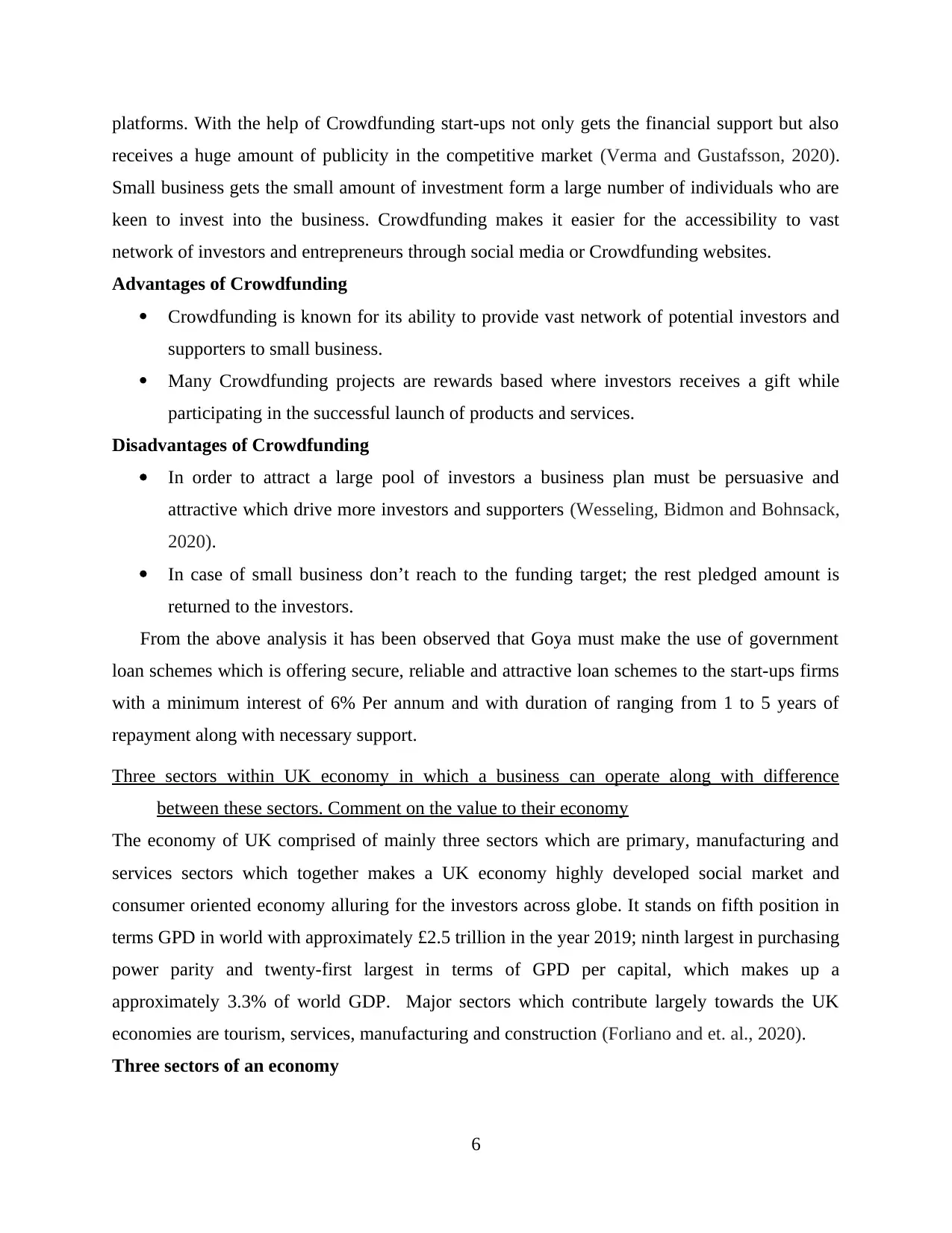
platforms. With the help of Crowdfunding start-ups not only gets the financial support but also
receives a huge amount of publicity in the competitive market (Verma and Gustafsson, 2020).
Small business gets the small amount of investment form a large number of individuals who are
keen to invest into the business. Crowdfunding makes it easier for the accessibility to vast
network of investors and entrepreneurs through social media or Crowdfunding websites.
Advantages of Crowdfunding
Crowdfunding is known for its ability to provide vast network of potential investors and
supporters to small business.
Many Crowdfunding projects are rewards based where investors receives a gift while
participating in the successful launch of products and services.
Disadvantages of Crowdfunding
In order to attract a large pool of investors a business plan must be persuasive and
attractive which drive more investors and supporters (Wesseling, Bidmon and Bohnsack,
2020).
In case of small business don’t reach to the funding target; the rest pledged amount is
returned to the investors.
From the above analysis it has been observed that Goya must make the use of government
loan schemes which is offering secure, reliable and attractive loan schemes to the start-ups firms
with a minimum interest of 6% Per annum and with duration of ranging from 1 to 5 years of
repayment along with necessary support.
Three sectors within UK economy in which a business can operate along with difference
between these sectors. Comment on the value to their economy
The economy of UK comprised of mainly three sectors which are primary, manufacturing and
services sectors which together makes a UK economy highly developed social market and
consumer oriented economy alluring for the investors across globe. It stands on fifth position in
terms GPD in world with approximately £2.5 trillion in the year 2019; ninth largest in purchasing
power parity and twenty-first largest in terms of GPD per capital, which makes up a
approximately 3.3% of world GDP. Major sectors which contribute largely towards the UK
economies are tourism, services, manufacturing and construction (Forliano and et. al., 2020).
Three sectors of an economy
6
receives a huge amount of publicity in the competitive market (Verma and Gustafsson, 2020).
Small business gets the small amount of investment form a large number of individuals who are
keen to invest into the business. Crowdfunding makes it easier for the accessibility to vast
network of investors and entrepreneurs through social media or Crowdfunding websites.
Advantages of Crowdfunding
Crowdfunding is known for its ability to provide vast network of potential investors and
supporters to small business.
Many Crowdfunding projects are rewards based where investors receives a gift while
participating in the successful launch of products and services.
Disadvantages of Crowdfunding
In order to attract a large pool of investors a business plan must be persuasive and
attractive which drive more investors and supporters (Wesseling, Bidmon and Bohnsack,
2020).
In case of small business don’t reach to the funding target; the rest pledged amount is
returned to the investors.
From the above analysis it has been observed that Goya must make the use of government
loan schemes which is offering secure, reliable and attractive loan schemes to the start-ups firms
with a minimum interest of 6% Per annum and with duration of ranging from 1 to 5 years of
repayment along with necessary support.
Three sectors within UK economy in which a business can operate along with difference
between these sectors. Comment on the value to their economy
The economy of UK comprised of mainly three sectors which are primary, manufacturing and
services sectors which together makes a UK economy highly developed social market and
consumer oriented economy alluring for the investors across globe. It stands on fifth position in
terms GPD in world with approximately £2.5 trillion in the year 2019; ninth largest in purchasing
power parity and twenty-first largest in terms of GPD per capital, which makes up a
approximately 3.3% of world GDP. Major sectors which contribute largely towards the UK
economies are tourism, services, manufacturing and construction (Forliano and et. al., 2020).
Three sectors of an economy
6
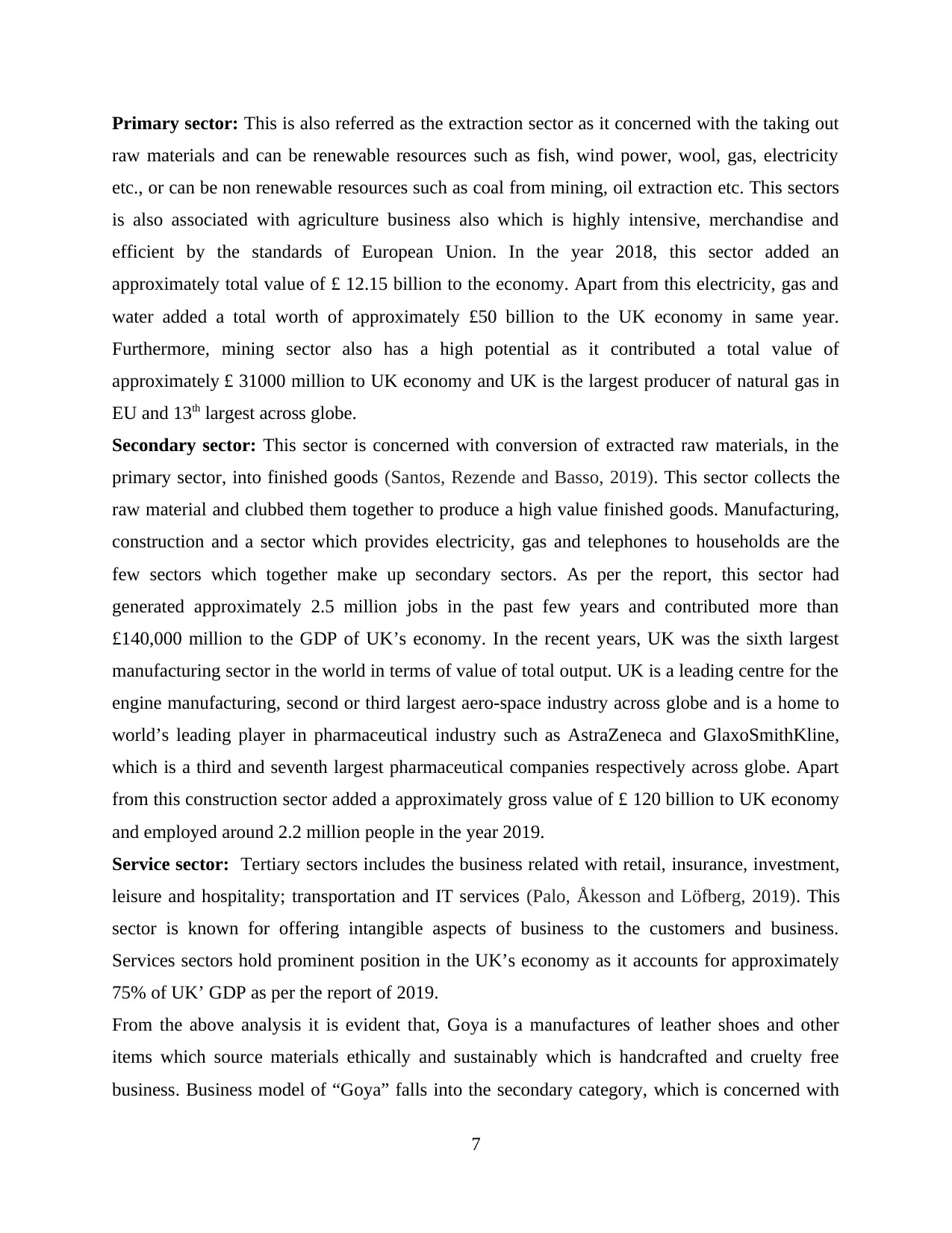
Primary sector: This is also referred as the extraction sector as it concerned with the taking out
raw materials and can be renewable resources such as fish, wind power, wool, gas, electricity
etc., or can be non renewable resources such as coal from mining, oil extraction etc. This sectors
is also associated with agriculture business also which is highly intensive, merchandise and
efficient by the standards of European Union. In the year 2018, this sector added an
approximately total value of £ 12.15 billion to the economy. Apart from this electricity, gas and
water added a total worth of approximately £50 billion to the UK economy in same year.
Furthermore, mining sector also has a high potential as it contributed a total value of
approximately £ 31000 million to UK economy and UK is the largest producer of natural gas in
EU and 13th largest across globe.
Secondary sector: This sector is concerned with conversion of extracted raw materials, in the
primary sector, into finished goods (Santos, Rezende and Basso, 2019). This sector collects the
raw material and clubbed them together to produce a high value finished goods. Manufacturing,
construction and a sector which provides electricity, gas and telephones to households are the
few sectors which together make up secondary sectors. As per the report, this sector had
generated approximately 2.5 million jobs in the past few years and contributed more than
£140,000 million to the GDP of UK’s economy. In the recent years, UK was the sixth largest
manufacturing sector in the world in terms of value of total output. UK is a leading centre for the
engine manufacturing, second or third largest aero-space industry across globe and is a home to
world’s leading player in pharmaceutical industry such as AstraZeneca and GlaxoSmithKline,
which is a third and seventh largest pharmaceutical companies respectively across globe. Apart
from this construction sector added a approximately gross value of £ 120 billion to UK economy
and employed around 2.2 million people in the year 2019.
Service sector: Tertiary sectors includes the business related with retail, insurance, investment,
leisure and hospitality; transportation and IT services (Palo, Åkesson and Löfberg, 2019). This
sector is known for offering intangible aspects of business to the customers and business.
Services sectors hold prominent position in the UK’s economy as it accounts for approximately
75% of UK’ GDP as per the report of 2019.
From the above analysis it is evident that, Goya is a manufactures of leather shoes and other
items which source materials ethically and sustainably which is handcrafted and cruelty free
business. Business model of “Goya” falls into the secondary category, which is concerned with
7
raw materials and can be renewable resources such as fish, wind power, wool, gas, electricity
etc., or can be non renewable resources such as coal from mining, oil extraction etc. This sectors
is also associated with agriculture business also which is highly intensive, merchandise and
efficient by the standards of European Union. In the year 2018, this sector added an
approximately total value of £ 12.15 billion to the economy. Apart from this electricity, gas and
water added a total worth of approximately £50 billion to the UK economy in same year.
Furthermore, mining sector also has a high potential as it contributed a total value of
approximately £ 31000 million to UK economy and UK is the largest producer of natural gas in
EU and 13th largest across globe.
Secondary sector: This sector is concerned with conversion of extracted raw materials, in the
primary sector, into finished goods (Santos, Rezende and Basso, 2019). This sector collects the
raw material and clubbed them together to produce a high value finished goods. Manufacturing,
construction and a sector which provides electricity, gas and telephones to households are the
few sectors which together make up secondary sectors. As per the report, this sector had
generated approximately 2.5 million jobs in the past few years and contributed more than
£140,000 million to the GDP of UK’s economy. In the recent years, UK was the sixth largest
manufacturing sector in the world in terms of value of total output. UK is a leading centre for the
engine manufacturing, second or third largest aero-space industry across globe and is a home to
world’s leading player in pharmaceutical industry such as AstraZeneca and GlaxoSmithKline,
which is a third and seventh largest pharmaceutical companies respectively across globe. Apart
from this construction sector added a approximately gross value of £ 120 billion to UK economy
and employed around 2.2 million people in the year 2019.
Service sector: Tertiary sectors includes the business related with retail, insurance, investment,
leisure and hospitality; transportation and IT services (Palo, Åkesson and Löfberg, 2019). This
sector is known for offering intangible aspects of business to the customers and business.
Services sectors hold prominent position in the UK’s economy as it accounts for approximately
75% of UK’ GDP as per the report of 2019.
From the above analysis it is evident that, Goya is a manufactures of leather shoes and other
items which source materials ethically and sustainably which is handcrafted and cruelty free
business. Business model of “Goya” falls into the secondary category, which is concerned with
7
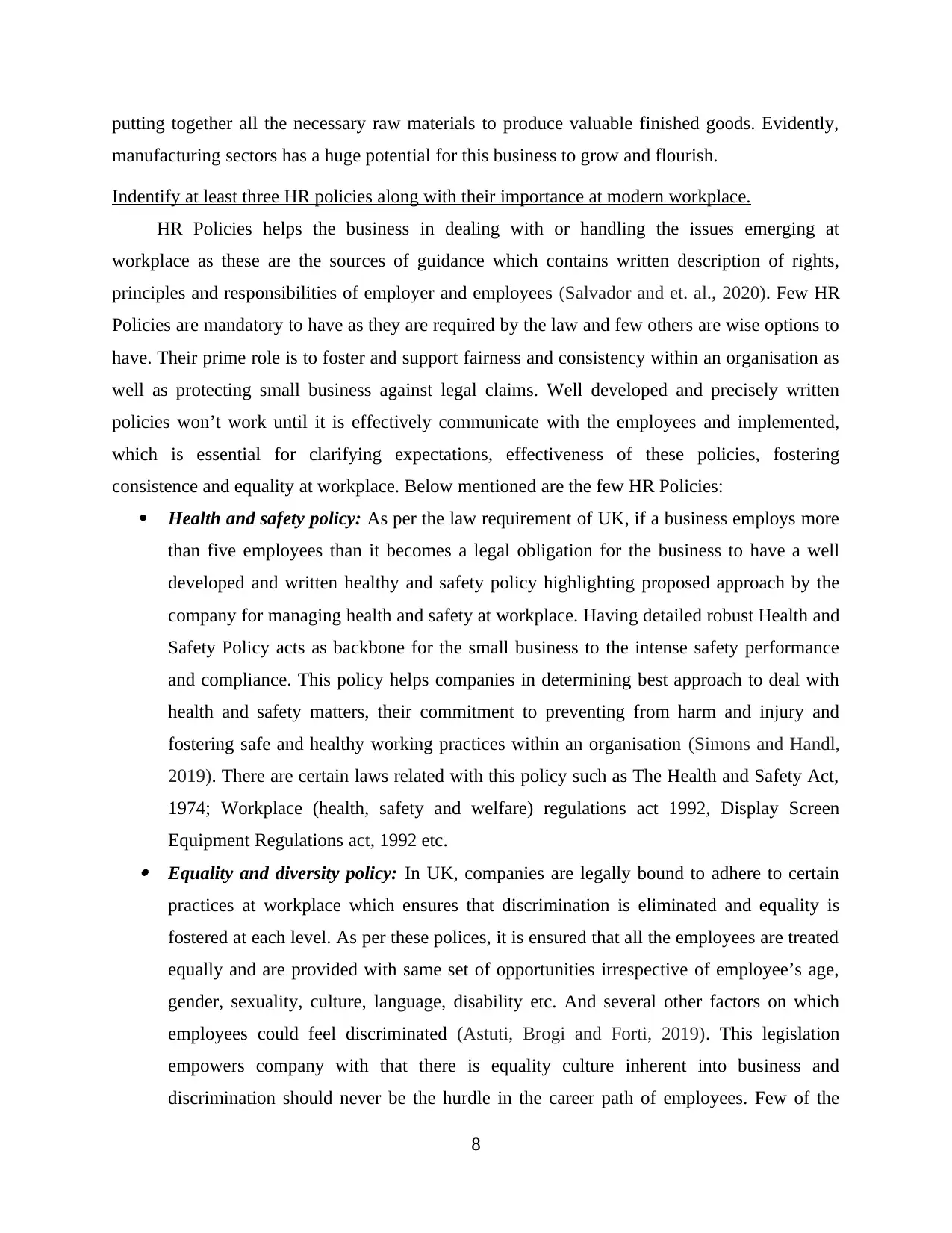
putting together all the necessary raw materials to produce valuable finished goods. Evidently,
manufacturing sectors has a huge potential for this business to grow and flourish.
Indentify at least three HR policies along with their importance at modern workplace.
HR Policies helps the business in dealing with or handling the issues emerging at
workplace as these are the sources of guidance which contains written description of rights,
principles and responsibilities of employer and employees (Salvador and et. al., 2020). Few HR
Policies are mandatory to have as they are required by the law and few others are wise options to
have. Their prime role is to foster and support fairness and consistency within an organisation as
well as protecting small business against legal claims. Well developed and precisely written
policies won’t work until it is effectively communicate with the employees and implemented,
which is essential for clarifying expectations, effectiveness of these policies, fostering
consistence and equality at workplace. Below mentioned are the few HR Policies:
Health and safety policy: As per the law requirement of UK, if a business employs more
than five employees than it becomes a legal obligation for the business to have a well
developed and written healthy and safety policy highlighting proposed approach by the
company for managing health and safety at workplace. Having detailed robust Health and
Safety Policy acts as backbone for the small business to the intense safety performance
and compliance. This policy helps companies in determining best approach to deal with
health and safety matters, their commitment to preventing from harm and injury and
fostering safe and healthy working practices within an organisation (Simons and Handl,
2019). There are certain laws related with this policy such as The Health and Safety Act,
1974; Workplace (health, safety and welfare) regulations act 1992, Display Screen
Equipment Regulations act, 1992 etc. Equality and diversity policy: In UK, companies are legally bound to adhere to certain
practices at workplace which ensures that discrimination is eliminated and equality is
fostered at each level. As per these polices, it is ensured that all the employees are treated
equally and are provided with same set of opportunities irrespective of employee’s age,
gender, sexuality, culture, language, disability etc. And several other factors on which
employees could feel discriminated (Astuti, Brogi and Forti, 2019). This legislation
empowers company with that there is equality culture inherent into business and
discrimination should never be the hurdle in the career path of employees. Few of the
8
manufacturing sectors has a huge potential for this business to grow and flourish.
Indentify at least three HR policies along with their importance at modern workplace.
HR Policies helps the business in dealing with or handling the issues emerging at
workplace as these are the sources of guidance which contains written description of rights,
principles and responsibilities of employer and employees (Salvador and et. al., 2020). Few HR
Policies are mandatory to have as they are required by the law and few others are wise options to
have. Their prime role is to foster and support fairness and consistency within an organisation as
well as protecting small business against legal claims. Well developed and precisely written
policies won’t work until it is effectively communicate with the employees and implemented,
which is essential for clarifying expectations, effectiveness of these policies, fostering
consistence and equality at workplace. Below mentioned are the few HR Policies:
Health and safety policy: As per the law requirement of UK, if a business employs more
than five employees than it becomes a legal obligation for the business to have a well
developed and written healthy and safety policy highlighting proposed approach by the
company for managing health and safety at workplace. Having detailed robust Health and
Safety Policy acts as backbone for the small business to the intense safety performance
and compliance. This policy helps companies in determining best approach to deal with
health and safety matters, their commitment to preventing from harm and injury and
fostering safe and healthy working practices within an organisation (Simons and Handl,
2019). There are certain laws related with this policy such as The Health and Safety Act,
1974; Workplace (health, safety and welfare) regulations act 1992, Display Screen
Equipment Regulations act, 1992 etc. Equality and diversity policy: In UK, companies are legally bound to adhere to certain
practices at workplace which ensures that discrimination is eliminated and equality is
fostered at each level. As per these polices, it is ensured that all the employees are treated
equally and are provided with same set of opportunities irrespective of employee’s age,
gender, sexuality, culture, language, disability etc. And several other factors on which
employees could feel discriminated (Astuti, Brogi and Forti, 2019). This legislation
empowers company with that there is equality culture inherent into business and
discrimination should never be the hurdle in the career path of employees. Few of the
8
Secure Best Marks with AI Grader
Need help grading? Try our AI Grader for instant feedback on your assignments.
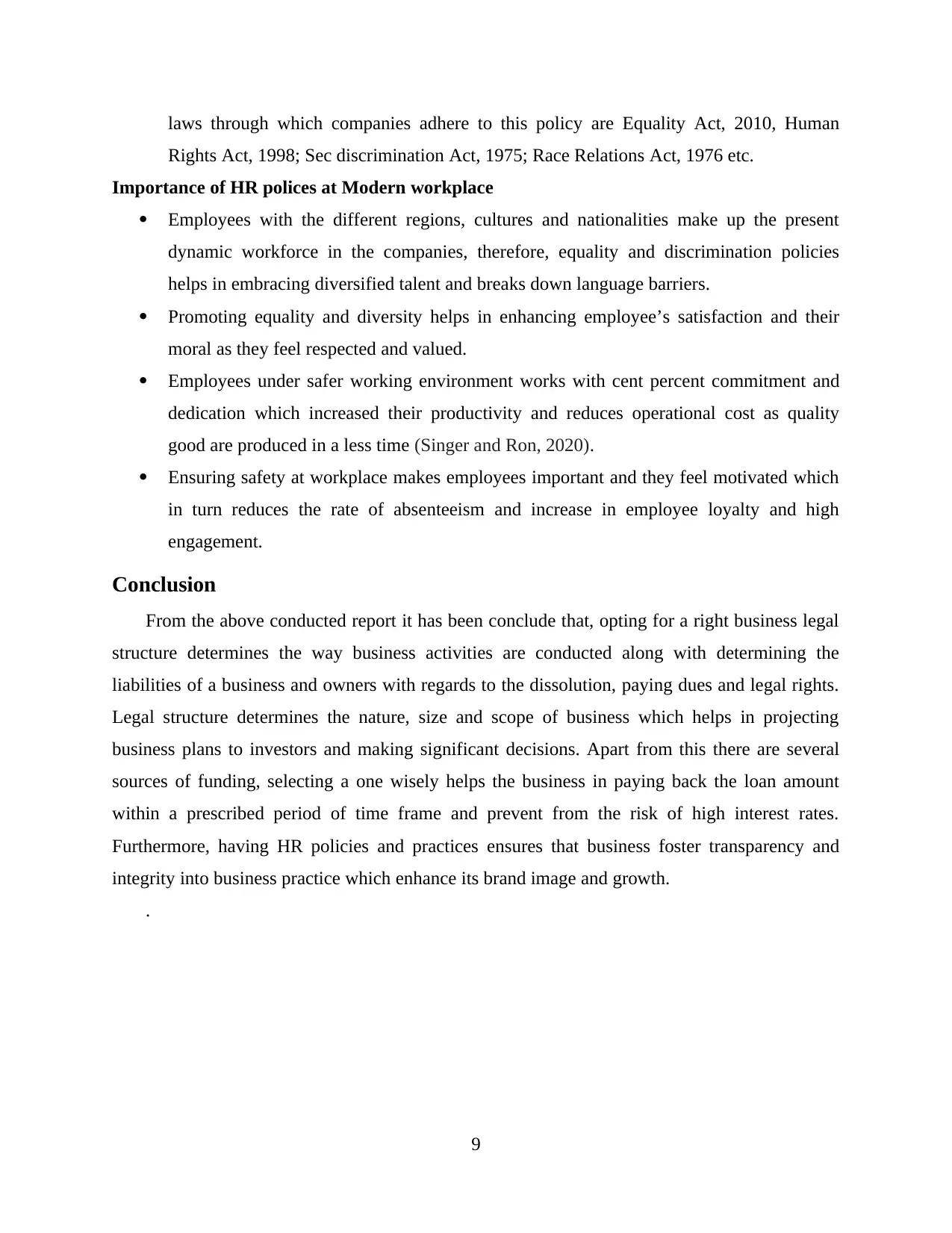
laws through which companies adhere to this policy are Equality Act, 2010, Human
Rights Act, 1998; Sec discrimination Act, 1975; Race Relations Act, 1976 etc.
Importance of HR polices at Modern workplace
Employees with the different regions, cultures and nationalities make up the present
dynamic workforce in the companies, therefore, equality and discrimination policies
helps in embracing diversified talent and breaks down language barriers.
Promoting equality and diversity helps in enhancing employee’s satisfaction and their
moral as they feel respected and valued.
Employees under safer working environment works with cent percent commitment and
dedication which increased their productivity and reduces operational cost as quality
good are produced in a less time (Singer and Ron, 2020).
Ensuring safety at workplace makes employees important and they feel motivated which
in turn reduces the rate of absenteeism and increase in employee loyalty and high
engagement.
Conclusion
From the above conducted report it has been conclude that, opting for a right business legal
structure determines the way business activities are conducted along with determining the
liabilities of a business and owners with regards to the dissolution, paying dues and legal rights.
Legal structure determines the nature, size and scope of business which helps in projecting
business plans to investors and making significant decisions. Apart from this there are several
sources of funding, selecting a one wisely helps the business in paying back the loan amount
within a prescribed period of time frame and prevent from the risk of high interest rates.
Furthermore, having HR policies and practices ensures that business foster transparency and
integrity into business practice which enhance its brand image and growth.
.
9
Rights Act, 1998; Sec discrimination Act, 1975; Race Relations Act, 1976 etc.
Importance of HR polices at Modern workplace
Employees with the different regions, cultures and nationalities make up the present
dynamic workforce in the companies, therefore, equality and discrimination policies
helps in embracing diversified talent and breaks down language barriers.
Promoting equality and diversity helps in enhancing employee’s satisfaction and their
moral as they feel respected and valued.
Employees under safer working environment works with cent percent commitment and
dedication which increased their productivity and reduces operational cost as quality
good are produced in a less time (Singer and Ron, 2020).
Ensuring safety at workplace makes employees important and they feel motivated which
in turn reduces the rate of absenteeism and increase in employee loyalty and high
engagement.
Conclusion
From the above conducted report it has been conclude that, opting for a right business legal
structure determines the way business activities are conducted along with determining the
liabilities of a business and owners with regards to the dissolution, paying dues and legal rights.
Legal structure determines the nature, size and scope of business which helps in projecting
business plans to investors and making significant decisions. Apart from this there are several
sources of funding, selecting a one wisely helps the business in paying back the loan amount
within a prescribed period of time frame and prevent from the risk of high interest rates.
Furthermore, having HR policies and practices ensures that business foster transparency and
integrity into business practice which enhance its brand image and growth.
.
9
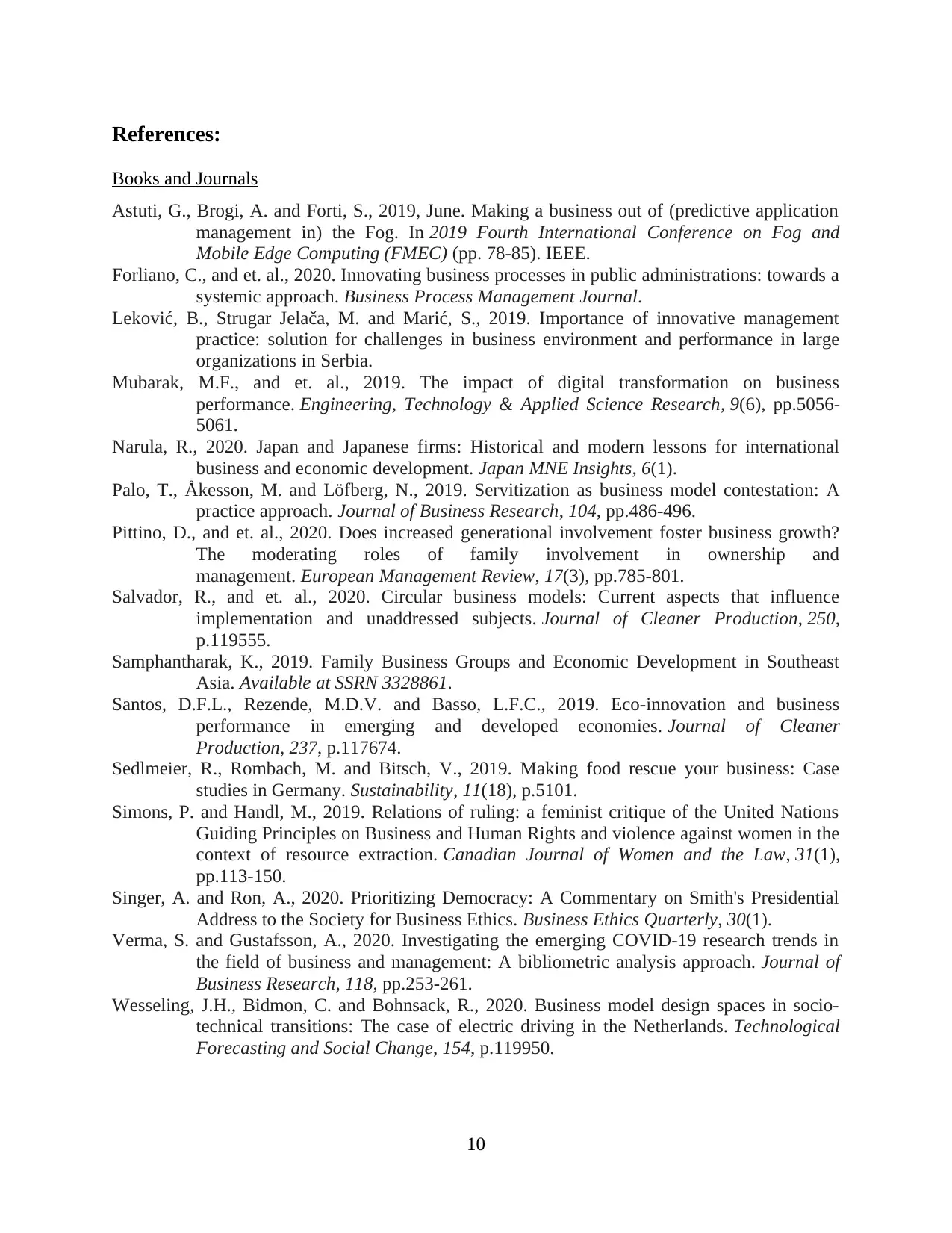
References:
Books and Journals
Astuti, G., Brogi, A. and Forti, S., 2019, June. Making a business out of (predictive application
management in) the Fog. In 2019 Fourth International Conference on Fog and
Mobile Edge Computing (FMEC) (pp. 78-85). IEEE.
Forliano, C., and et. al., 2020. Innovating business processes in public administrations: towards a
systemic approach. Business Process Management Journal.
Leković, B., Strugar Jelača, M. and Marić, S., 2019. Importance of innovative management
practice: solution for challenges in business environment and performance in large
organizations in Serbia.
Mubarak, M.F., and et. al., 2019. The impact of digital transformation on business
performance. Engineering, Technology & Applied Science Research, 9(6), pp.5056-
5061.
Narula, R., 2020. Japan and Japanese firms: Historical and modern lessons for international
business and economic development. Japan MNE Insights, 6(1).
Palo, T., Åkesson, M. and Löfberg, N., 2019. Servitization as business model contestation: A
practice approach. Journal of Business Research, 104, pp.486-496.
Pittino, D., and et. al., 2020. Does increased generational involvement foster business growth?
The moderating roles of family involvement in ownership and
management. European Management Review, 17(3), pp.785-801.
Salvador, R., and et. al., 2020. Circular business models: Current aspects that influence
implementation and unaddressed subjects. Journal of Cleaner Production, 250,
p.119555.
Samphantharak, K., 2019. Family Business Groups and Economic Development in Southeast
Asia. Available at SSRN 3328861.
Santos, D.F.L., Rezende, M.D.V. and Basso, L.F.C., 2019. Eco-innovation and business
performance in emerging and developed economies. Journal of Cleaner
Production, 237, p.117674.
Sedlmeier, R., Rombach, M. and Bitsch, V., 2019. Making food rescue your business: Case
studies in Germany. Sustainability, 11(18), p.5101.
Simons, P. and Handl, M., 2019. Relations of ruling: a feminist critique of the United Nations
Guiding Principles on Business and Human Rights and violence against women in the
context of resource extraction. Canadian Journal of Women and the Law, 31(1),
pp.113-150.
Singer, A. and Ron, A., 2020. Prioritizing Democracy: A Commentary on Smith's Presidential
Address to the Society for Business Ethics. Business Ethics Quarterly, 30(1).
Verma, S. and Gustafsson, A., 2020. Investigating the emerging COVID-19 research trends in
the field of business and management: A bibliometric analysis approach. Journal of
Business Research, 118, pp.253-261.
Wesseling, J.H., Bidmon, C. and Bohnsack, R., 2020. Business model design spaces in socio-
technical transitions: The case of electric driving in the Netherlands. Technological
Forecasting and Social Change, 154, p.119950.
10
Books and Journals
Astuti, G., Brogi, A. and Forti, S., 2019, June. Making a business out of (predictive application
management in) the Fog. In 2019 Fourth International Conference on Fog and
Mobile Edge Computing (FMEC) (pp. 78-85). IEEE.
Forliano, C., and et. al., 2020. Innovating business processes in public administrations: towards a
systemic approach. Business Process Management Journal.
Leković, B., Strugar Jelača, M. and Marić, S., 2019. Importance of innovative management
practice: solution for challenges in business environment and performance in large
organizations in Serbia.
Mubarak, M.F., and et. al., 2019. The impact of digital transformation on business
performance. Engineering, Technology & Applied Science Research, 9(6), pp.5056-
5061.
Narula, R., 2020. Japan and Japanese firms: Historical and modern lessons for international
business and economic development. Japan MNE Insights, 6(1).
Palo, T., Åkesson, M. and Löfberg, N., 2019. Servitization as business model contestation: A
practice approach. Journal of Business Research, 104, pp.486-496.
Pittino, D., and et. al., 2020. Does increased generational involvement foster business growth?
The moderating roles of family involvement in ownership and
management. European Management Review, 17(3), pp.785-801.
Salvador, R., and et. al., 2020. Circular business models: Current aspects that influence
implementation and unaddressed subjects. Journal of Cleaner Production, 250,
p.119555.
Samphantharak, K., 2019. Family Business Groups and Economic Development in Southeast
Asia. Available at SSRN 3328861.
Santos, D.F.L., Rezende, M.D.V. and Basso, L.F.C., 2019. Eco-innovation and business
performance in emerging and developed economies. Journal of Cleaner
Production, 237, p.117674.
Sedlmeier, R., Rombach, M. and Bitsch, V., 2019. Making food rescue your business: Case
studies in Germany. Sustainability, 11(18), p.5101.
Simons, P. and Handl, M., 2019. Relations of ruling: a feminist critique of the United Nations
Guiding Principles on Business and Human Rights and violence against women in the
context of resource extraction. Canadian Journal of Women and the Law, 31(1),
pp.113-150.
Singer, A. and Ron, A., 2020. Prioritizing Democracy: A Commentary on Smith's Presidential
Address to the Society for Business Ethics. Business Ethics Quarterly, 30(1).
Verma, S. and Gustafsson, A., 2020. Investigating the emerging COVID-19 research trends in
the field of business and management: A bibliometric analysis approach. Journal of
Business Research, 118, pp.253-261.
Wesseling, J.H., Bidmon, C. and Bohnsack, R., 2020. Business model design spaces in socio-
technical transitions: The case of electric driving in the Netherlands. Technological
Forecasting and Social Change, 154, p.119950.
10

[Online] Available through: <https://www.investopedia.com/articles/investing/042915/how-uk-
makes-money.asp
>./
[Online] Available through: <https://www.statista.com/statistics/270372/distribution-of-gdp-
across-economic-sectors-in-the-united-kingdom/
>./
11
makes-money.asp
>./
[Online] Available through: <https://www.statista.com/statistics/270372/distribution-of-gdp-
across-economic-sectors-in-the-united-kingdom/
>./
11
1 out of 13
Related Documents
Your All-in-One AI-Powered Toolkit for Academic Success.
+13062052269
info@desklib.com
Available 24*7 on WhatsApp / Email
![[object Object]](/_next/static/media/star-bottom.7253800d.svg)
Unlock your academic potential
© 2024 | Zucol Services PVT LTD | All rights reserved.





